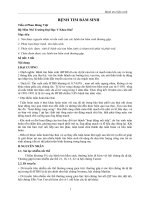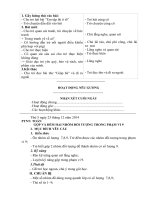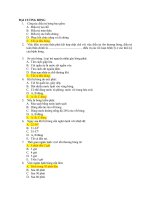Đại cương tim bẩm sinh nguyễn lân hiếu
Bạn đang xem bản rút gọn của tài liệu. Xem và tải ngay bản đầy đủ của tài liệu tại đây (3.99 MB, 113 trang )
Nguyễn Lân Hiếu
Question 1
51 yr old male with no past medical history presents with chest
pain
ECG is normal
Stress echocardiogram is negative for ischemic changes
Color Doppler interrogation demonstrates a patent foramen ovale
with a small bidirectional shunt
Agitated saline injection is positive for a small right-to-left
shunt
What is the best disposition for this patient?
A. Cardiac MRI to evaluate right ventricular volume
B. No further testing
C. Clopidogrel 75 mg PO and Aspirin 325mg PO daily
D. Device closure of the patent foramen ovale
Question 1: Answer
A. A patent foramen ovale should not result in
right ventricular volume overload. Therefore,
MRI is not indicated
B. A patent foramen ovale is present in ~25% of
the adult population. The chest pain is
unrelated to this finding.
C. No data supports medical therapy to prevent
paradoxical emboli in an asymptomatic patient
D. No data supports device or surgical closure to
prevent paradoxical emboli in an asymptomatic
patient
Secundum ASDPatent foramen ovale
Hagen et al. Mayo Clin Proc 59:17-20, 1984.
Septum
secundum
Septum primum
RA
LA
• Interatrial communication present in fetal life
LARA
• Lack of fusion between:
– Septum primum
– Septum secundum
Patent Foramen Ovale (PFO)
• Prevalence of PFO ~26% of population
• ~35% age up to 30 yo ~20% age > 80 yo
Cabanes et al. J Am Soc
Echocardiogr 15: 441-6, 2002.
PFO Diagnosis
• Ultrasound-based imaging modalities used in
the detection of R L shunt
• Transthoracic echo with agitated saline / contrast
• Small shunt: 1 - 10 bubbles in LA
• Medium shunt: 10 - 30 bubbles
• Large shunt: > 30 bubbles
• Transesophageal echo with agitated saline / contrast
• Transcranial Doppler ultrasonography with contrast
• Cryptogenic stroke• Cryptogenic stroke
Conditions/Pathology Associated with PFO
• Paradoxical arterial embolism
• Migraine
• Platypnea – orthodeoxia syndrome
• Decompression illness
• Transient global amnesia
• Obstructive sleep apnea
• Liver transplantation complications
• Varicose veins
• Pacemaker wires
Bugra et al. H. Throm Thrombolysis; 10:(1) 2007
Paradoxical Embolism from RL Shunts
Question 2
A 30 year old female presents with a persistent cough
Chest x-ray demonstrates cardiomegaly
Echocardiogram demonstrates increased velocity across
the pulmonary valve (peak velocity 2.2 m/sec) and
moderate right heart chamber enlargement
What is the next step in management?
A. Annual evaluations to assess for ventricular
dysfunction
B. Cardiopulmonary exercise testing
C. Additional echo imaging to demonstrate a
secundum ASD
D. Cardiac catheterization with balloon pulmonary
valvuloplasty
Question 2: Answer
A. There is no indication of ventricular dysfunction
B. Additional information required to explain chamber
dilation. Exercise testing would not provide the
needed information
C. A hemodynamically significant ASD will result in
right atrial and right ventricular dilation
D. The increased flow acceleration across the
pulmonary valve is mild. A valvuloplasty procedure
is not indicated in this setting. Moreover, the ASD
would result in increased flow and a “physiologic
stenosis” of the valve that would resolve after
ASD closure.
Question 3
A 62 year old female presents with a murmur and exertional dyspnea
Past medical history is significant for systemic hypertension
Treated with a beta blocker and ACE inhibitor
2D echocardiogram demonstrates an 8mm secundum ASD with left-to-
right shunting, normal left ventricular systolic function, moderate
thickening of the left ventricular wall without regional wall motion
abnormalities, mild right ventricular dilation with normal systolic function.
No outflow tract obstruction was observed.
What is the best intervention?
A. Continuation of current medical therapy and 1 year follow-up
B. Initiation of aspirin 325mg daily and 1 year follow-up
C. Left and right heart catheterization
D. Device closure of the ASD
Question 3: Answer
A. No change in management is not appropriate with the new
finding of an ASD and left ventricular enlargement
B. Aspirin therapy does not address the 2 key findings on this
echocardiogram
C. Left and right heart catheterization will help to determine filling
pressures. If elevated, test occlusion of the ASD could allow
evaluation of left atrial pressure to determine if will increase after
device closure.
D. An ASD may cause right heart dilation from the left-to-right shunt,
but in an adult patient with systemic hypertension, new onset
exertional dyspnea may be attributed to evolving left ventricular
diastolic dysfunction and the resulting increase in left-to-right
shunting. ASD closure may lead to increased symptoms if left
ventricular filling pressures are high as left atrial pressures will
increase without the ASD “pop-off.”
Atrial Septal Defect
10% of all CHD
3 types
• Secundum
• Primum
• Sinus venosus
2:1 female to male ratio of secundum type
Excluding BAV, ASDs are most encountered
unrepaired CHD in adults
Natural History of ASDs
Symptoms early in life are rare
CHF rare < 40 years old
Atrial arrhythmias: increased frequency
in older patients
• 13% in > 40 year old
• 52% in > 60 year old
Pulmonary HTN occurs in older patients
with untreated ASDs
• Usually occurs > 20 year old
• Up to 1/3 of patients in 3
rd
decade of life
• Predominantly in females
Secundum ASD
Secundum ASD most
common type
Adults often
asymptomatic
Fixed split S2
ECG – RVH, RBBB, RAD
(secundum), LAD
(primum)
Indications for closure:
Qp:Qs > 1.5
RA +/- RV enlargement
Symptoms
N. Engl. J. Med. 342(4) 256-63, 2000
Atrial Septal Defect
Amplatzer
Septal Occluder
HELEX Septal
Occluder
TEE Image
ICE Image
Other ASD Types
Ostium Primum Defect
A form of AV canal defect
Often associated with a cleft mitral valve
Common in Down Syndrome
Requires surgical closure
Sinus Venosus Defect
10% of all ASDs
Most common are near SVC junction
○ Can be associated with anomalous pulmonary
veins
Requires surgical closure
ASD
Complications/Management
• SBE prophylaxis not needed except:
For 6 months after closure
• Usually no activity restrictions
• Pregnancy well tolerated if no pulmonary
hypertension
Closure recommended before childbearing due
to increased potential risk of thromboembolism
Question 4
All of the following conditions result in an
increased risk of erosion in the setting of
ASD device closure EXCEPT:
A. An aortic rim length of less than 5 mm
B. Determining the defect size utilizing
balloon stretch diameter
C. A deficient inferior atrial rim
D. A small pericardial effusion noted 24
hours after device implant
Question 4: Answer
All of the following conditions contribute
to an increased risk of erosion in the
setting of ASD device closure EXCEPT:
A. An aortic rim length of less than 5 mm
B. Determining the device size utilizing
balloon stretch diameter
C. A deficient inferior atrial rim
D. A small pericardial effusion noted 24
hours after device implant
ASD Device Closure and
Erosion
Erosion risk is low
Incidence is 0.1%
Associated with
Oversized devices
Balloon stretched diameter to determine device size
Device deformation at the aortic root
Aortic rim length < 5 mm
○ 60% have deficient aortic rim (Pediatr Cardiol 2014 May 14)
Superior location of the defect (deficient superior rim)
Presence of pericardial effusion within 24 hrs of implant
Catheter Cardiovasc Interv 2004;63:496-502
Catheter Cardiovasc Interv 2014;83:84-92
ASD Device Closure and
Erosion
A. RA/LA free wall in
close proximity to
device edge
B. Cardiac cycle
creates “see-saw”
motion
• Atrial trauma
C. Result = erosion &
subsequent
hemodynamic
compromise
Catheter Cardiovasc Interv 2004;63:496-502
Catheter Cardiovasc Interv 2014;83:84-92
ASD Device Closure and
Erosion
Catheter Cardiovasc Interv 2014;83:84-92
• TEE - Short
Axis
– Absent aortic
rim (bald)
– Thin
posterior rim
Question 5
A 45 year old male falls from a ladder and fractures his right ulna.
ER evaluation reveals a murmur and a cardiology consultation is
requested.
Physical examination reveals a 3/6 holosystolic murmur at the left
lower sternal border with radiation to the apex and back
ECG is normal
Echocardiography demonstrates a muscular ventricular septal
defect with a peak systolic velocity of 5.2 m/sec. Normal
biventricular size & function. Tricuspid regurgitation velocity
estimates normal right ventricular pressure
What is the most appropriate management?
A. No intervention
B. Restriction of vigorous physical activity and SBE prophylaxis
C. Cardiac catheterization to quantify ventricular level shunting
D. Percutaneous device closure of the ventricular septal defect
Question 5: Answer
A. A small VSD may be missed if a patient has not had routine
medical evaluation. Decision making regarding a newly found
defect is based upon clinical findings. Indications for
intervention include: Left atrial and ventricular enlargement,
elevated right ventricular pressure, low velocity flow across the
defect indicating a less-restrictive defect. None of these are
present in this patient
B. No physical activity restrictions are necessary. SBE prophylaxis
is not indicated
C. Echocardiography adequately assesses the degree of shunting
D. With hemodynamic consequence, there is no indication for
closure of this defect. The patient should be reassured that it is
benign
Ventricular Septal Defect
Most common CHD seen in childhood and
young adult life
Presentation
Small defect
○ Palpable thrill, harsh holosystolic murmur
○ Normal CXR and ECG
Large defect and pulmonary HTN
○ Cyanosis, arrhythmia, syncope, hemoptysis
○ Loud S2, soft or absent murmur
○ CXR – CMG, ECG – BVH
○ Left atrial / ventricle dilation









